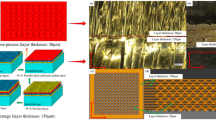Abstract
Designing a high-performance solid carbide end mill is difficult due to the complex relationship between end mill geometry and numerous or conflicting design goals. Earlier approaches of computer-aided solid end mill design are limited to only a few design aspects. This article presents a three-dimensional finite element method of milling process for solid carbide end mill design and optimization. The software was secondarily developed based on UG platform, integrating the parametric design with the development of the two-dimension drawing of solid carbide end mill. The three-dimension finite element simulation for milling Ti-6Al-4V alloy was performed and the geometrical parameters were optimized based on the objective of low cutting force and cutting temperature. As a result, a simulation-based design and optimization of geometrical parameters of tool structure and cutting edge is possible. The optimized results, for the geometrical parameters of tool structure and cutting edge when milling titanium alloy using a 20-mm diameter solid carbide end mill, is a 12-mm diameter of inner circle, four flutes, a 45 ° helix angle, and a 9 ° rake angle of the side cutting edge.
Similar content being viewed by others
References
Chen RY (2002) Principles of metal cutting (2nd Edition). Mach Indust Press, Beijing
Daridon L, Oussouaddi O, Ahzi S (2004) Influence of the material constitutive models on the adiabatic shear band spacing: MTS, power law and Johnson–Cook models. Int J Solids Struct 41(11–12):3109–3124
Hou YT, Yu XY (2007) UG/Open secondary development and sperm solutions. Chemical Industry Press, Beijing
Johnson GR, Cook WH (1983) A constitutive model and data for metals subjected to large strains high strain rates and high temperature. Proc 7th Int Symp Ballistics, Hague, Netherlands: 541–547.
Kim YH, Ko SL (2002) Development of design and manufacturing technology for end mills in machining hardened steel. J Mater Process Technol 130:653–661
Kim JH, Park JW, Ko TJ (2008) End mill design and machining via cutting simulation. Comput Aided Des 40(3):324–333
Kimura Y, Takeyama H (2009) Development of a high performance end mill based on the analysis of chip flow generated by curved rake face. CIRP Ann Manuf Technol 52(1):57–60
Ku HS, Chia WC (2006) Design of multi-purpose carbide end mill. Inst Eng Malays J 67(2):34–40
Li HD (2007) Optimization design of end mill. Manuf Technol Mach Tool 5:25–27
List G, Sutter G, Bouthiche A (2012) Cutting temperature prediction in high speed machining by numerical modelling of chip formation and its dependence with crater wear. Int J Mach Tools Manuf 54–55:1–9
Nie SQ, Meng GW (2004) Material mechanics. Mach Indust Press, Beijing
Reddy NSK, Rao PV (2005) Selection of optimum tool geometry and cutting conditions using a surface roughness prediction model for end milling. Int J Adv Manuf Technol 26(11–12):1202–1210
Song QH (2009) High speed milling stability and machining accuracy. Dissertation, Shandong University
Song QH, Ai X, Zhao J (2011) Design for variable pitch end mills with high milling stability. Int J Adv Manuf Technol 55(9–12):891–903
Tandon P, Gupta P, Dhande SG (2005) Geometric modeling of end mills. Comput Aided Des Appl 2(1–4):57–66
Tandon P, Rajik Khan M (2009) Three dimensional modeling and finite element simulation of a generic end mill. Comput Aided Des 41(2):106–114
Xu H (1993) Machine design handbook. China Machine Press, Beijing
Xu ZG, Zhao B (2006) Research on the design and management of carbide end mill. SICE-ICASE, Int Joint Confer IEEE: 2862–2867
Author information
Authors and Affiliations
Corresponding author
Rights and permissions
About this article
Cite this article
Li, A., Zhao, J., Pei, Z. et al. Simulation-based solid carbide end mill design and geometry optimization. Int J Adv Manuf Technol 71, 1889–1900 (2014). https://doi.org/10.1007/s00170-014-5638-5
Received:
Accepted:
Published:
Issue Date:
DOI: https://doi.org/10.1007/s00170-014-5638-5




